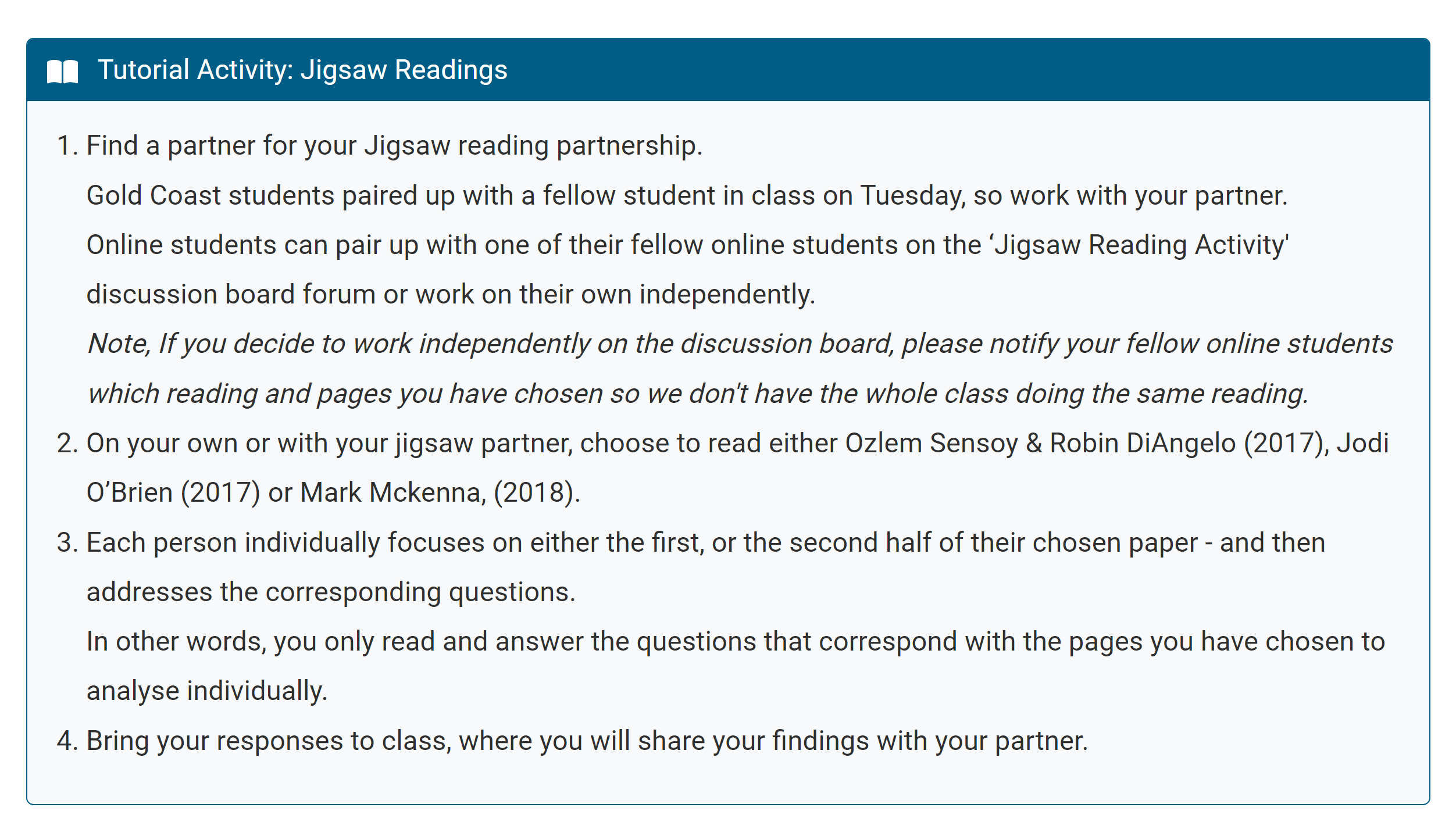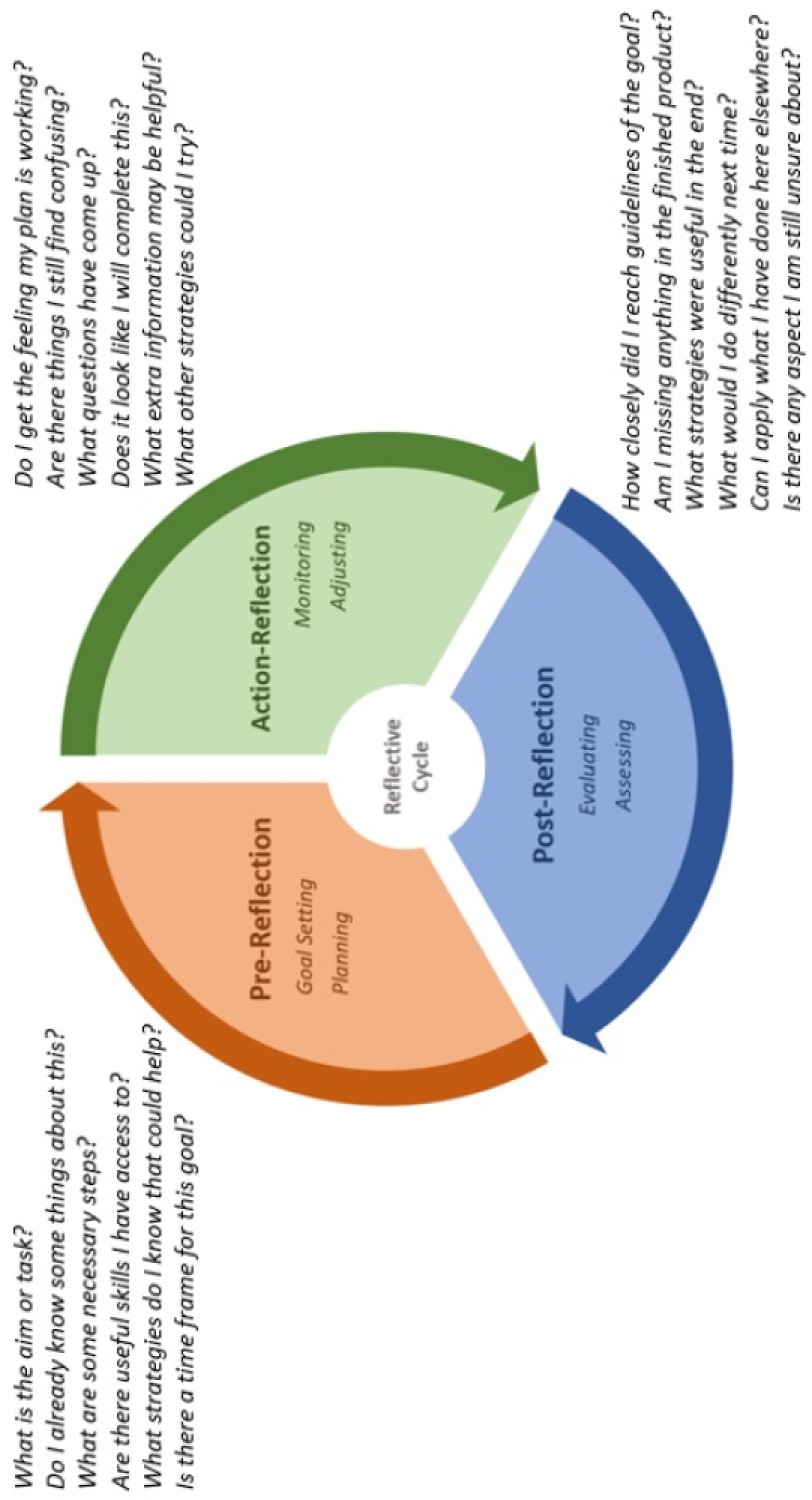Purposeful Learning Activities: examples of best practice
Learning activities are essential to student understanding and progress towards learning outcomes. Purposeful learning activities ensure that students are engaged in their learning, through the use of active learning approaches in class, online, and when studying self-access materials. Active learning involves students actively engaging with the material and seeking out new knowledge, rather than receiving information passively.
Purposeful learning activities guide students and enable them to process, integrate and understand unit materials. Watching videos, listening to podcasts, and reading articles expose students to content and information: but do not provide students with opportunities to demonstrate their understanding or application. Ensuring unit materials include suitable learning activities is essential for student learning and engagement.
When selecting an activity, it's important to ensure it relates directly to the content covered and is relevant to the learning outcomes. Purposeful activities clearly outline student expectations and provide timely and relevant feedback that supports student learning. Learning activities can also incorporate elements that build a community, utilize online tools for interaction, promote the exchange of ideas, and create a student-centred environment (Poll and Weller 2014).
The following examples in this article align with the Southern Cross Model and incorporate these critical elements in a range of ways.
More examples
More example learning activities organised around the Communities of Inquiry (Col) model can be viewed on the Introducing the Southern Cross Model (ISCM) site.
Activities that Explore Information
The following activities allow students to explore new ideas and information and build their understanding. Students can add to their existing knowledge and skills, clarify their understanding of material, and gain new perspectives. Explore activities can include, interactive videos and tours, discussions, debates, or reading activities.
H5P Timeline
This activity from MDIA2004 Making Radio and Podcasts helps students to contextualise the production techniques of today within the technical and social history of radio as a mass communication tool. Learners are asked to explore the history of both radio and the evolution of the burgeoning podcast industry, with an emphasis on Australia, and to reflect on what they already know about the history of radio and podcasting.
Once students have completed this activity, they have background context to support reading an article on how podcasting has led to a renaissance for the field of audio documentary and drama.
H5P Virtual tour (360)
This activity demonstrates how an H5P Virtual tour exercise can be used to familiarise students with important contextual elements of a maternity ward. Students explore the different prompts such as text, quizzes, videos and links in which they can check their knowledge and reflect on what they have learned as they proceed.
Activities that promote Group interaction
Group activities allow students opportunities to interact and share their ideas. The ability for students to work cooperatively in a team is a more highly valued employability skill than the ability to work independently. Cooperative learning in groups allows students to become active participants in their learning. Students develop skills such as problem-solving, negotiation, conflict resolution, leadership, critical thinking and time management.
Jigsaw Readings: tutorial activity
This activity from CLST3002 Borderlands: Identity, Culture and Belonging allows learners to build social connections and support each others' learning through by analysing ideas and concepts within readings and sharing their findings.
It is suitable for both face-to-face, blended and online learning. In addition, jigsaw readings activities make readings more engaging, accessible and much quicker for students.
Learners read different paragraphs with questions corresponding to page numbers in each paper. The jigsaw readings come together as a whole article in follow-up tutorials where learners take notes of each other's findings. The self and group aspects of this task make it a richer and more meaningful learning opportunity for students.
Activities that guide Reflection
Reflective activities provide opportunities for students to deepen thought, improve their learning process, and to master ideas. Reflective students become independent lifelong learners and improve their ability to achieve learning outcomes.
Using reflective activities, students reflect on what they are or will be learning, monitor how they are going, and then evaluate and assess how well they achieved their learning goals, what they learned, and what they could do differently. This forms a reflective cycle (Storie, 2021).
- Pre-Reflection is reflection done before the task is started and involves identifying the goal and creating a plan.
- Action-Reflection is initiated during the task to monitor and adjust the progress and strategies.
- Post-Reflection is reflection at the conclusion of the task to evaluate and assess success.
Figure 1: The Reflective Cycle (Storie, 2021)
Consider how you might include student reflection before, during, or after a learning experience.
H5P Interactive book
In this reflective activity, students read an article, identify the theory supporting the author's statement about different stages being non-linear and then apply them to their own professional practice.
H5P Documentation Tool
At the end of each module, students studying HLTH6002 Metabolic Health and Management are directed to reflect on what they have learned. After students complete their responses, they can download and save these for future reference. This activity helps students identify what they have learned from each module and how it applies to them; an essential component of lifelong learning.
Activities that use Case Studies
A case study is an in-depth, intensive study of a particular case or scenario, with the purpose of understanding a broader set of similar situations. Students are able to analyze authentic cases and to apply their knowledge and skills to real-world contexts. For example, a medical student might need to diagnose a patient, or a business student might be required to evaluate an organisation's business strategy.
H5P Course presentation
Students studying INDG1003 The Mental Health of Australian Indigenous Peoples, are presented with case studies that provide a rich context for examining the social, and political issues impacting the psychological wellbeing of Indigenous people.
The following interactive H5P course presentation concerns a case study of Indigenous woman Naomi Williams and uses text, audio and video format. Students are asked to reflect on what they have learned after engaging with the materials.
H5P Interactive video using a motion image animation
This short video was created by the Digital Resources team for LAWS2055 Criminal Process to transform a legal case (R v Rondo) into a short motion graphic animation, which was then further developed into an H5P interactive video.
Before completing this activity, learners read about police investigation powers relating to search and seizure. They then watch the short video and complete the quiz questions throughout it to check their understanding of the learning content. Instant feedback is provided to students once they complete each section. A link to the R V Rondo case allows students to access the full report in text format.
Activities that Revise and Summarise
Summary and revision activities, such as quizzes with immediate feedback, allow students to review the course content and identify gaps in their knowledge and skills and what they need to improve upon to succeed.
H5P Drag and drop
In this revision activity from HBIO1009 Anatomy and Physiology, students study the interaction of hormones. Students watch a short video about neurohormones and the higher centres within the endocrine system, and then complete the following H5P drag-and-drop activity by dragging the correct hypothalamic and anterior pituitary tropic hormones to the correct diagram location. Once students complete the activity and review feedback, they can view a summary of the topic and download a pdf table summarising the endocrine glands and organs.
H5P Branching scenario
This activity is designed to simulate a nurse's experience working in an emergency ward within a hospital. Learners work through revision and problem-solving exercises, triaging and treating patients. Branching scenarios are useful at the end of a topic, module or unit because they allow learners to apply their knowledge and skills in authentic situations.
More Activity Ideas
Learning activities provide opportunities for students to engage with the unit materials and each other online, in self-access modules, and in class tutorials and workshops.
Some activity ideas:
- Pose a question for students to comment on in the discussion board
- Prompt students to respond (respectfully) to each other's questions and comments in the discussion board
- Ask students to contribute to a shared document (such as a Bb wiki or Zoom Whiteboard) to solve a problem or build a shared understanding of a topic
- Ask students to work in pairs or small groups in an online or class learning activity (Think/Pair/Share is a popular approach)
- Use a polling tool (e.g. Kahoot! or Zoom Poll) to poll students’ opinions on a topic and show real-time responses.
H5P learning activities
You can learn more about H5P and interactive learning activities in the following guide: H5P: Create interactive resources
More technology tools
You can learn more about the different technology tools for teaching in the following article: Technology integration
References
K. Poll, J. Widen, and S. Weller (2014). Six Instructional Best Practices for Online Engagement and Retention. Journal of Online Doctoral Education, 1, 1: 56-72, 2014. https://ecommons.luc.edu/english_facpubs/30/.
Storie B. (2021). Reflecting with Purpose: A Research-Backed, Educator's Guide to Fostering Student Reflection, https://pressbooks.bccampus.ca/reflectingwithpurpose/.

